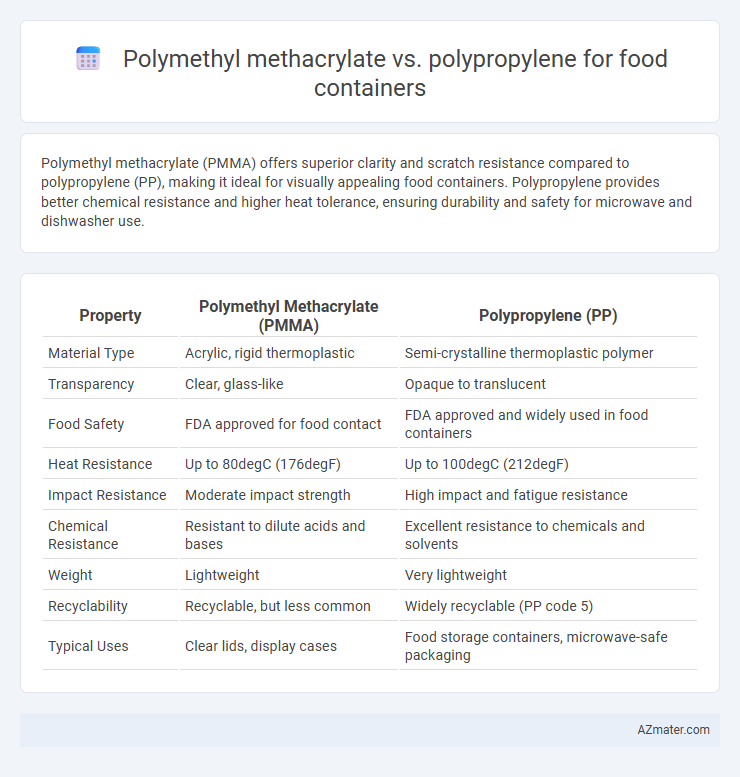Polymethyl methacrylate (PMMA) offers superior clarity and scratch resistance compared to polypropylene (PP), making it ideal for visually appealing food containers. Polypropylene provides better chemical resistance and higher heat tolerance, ensuring durability and safety for microwave and dishwasher use.
Table of Comparison
| Property | Polymethyl Methacrylate (PMMA) | Polypropylene (PP) |
|---|---|---|
| Material Type | Acrylic, rigid thermoplastic | Semi-crystalline thermoplastic polymer |
| Transparency | Clear, glass-like | Opaque to translucent |
| Food Safety | FDA approved for food contact | FDA approved and widely used in food containers |
| Heat Resistance | Up to 80degC (176degF) | Up to 100degC (212degF) |
| Impact Resistance | Moderate impact strength | High impact and fatigue resistance |
| Chemical Resistance | Resistant to dilute acids and bases | Excellent resistance to chemicals and solvents |
| Weight | Lightweight | Very lightweight |
| Recyclability | Recyclable, but less common | Widely recyclable (PP code 5) |
| Typical Uses | Clear lids, display cases | Food storage containers, microwave-safe packaging |
Introduction to Food-Grade Plastics: PMMA vs Polypropylene
Polymethyl methacrylate (PMMA) and polypropylene (PP) are widely used food-grade plastics, prized for their distinct properties in food container applications. PMMA offers excellent clarity and scratch resistance, making it ideal for transparent containers that showcase food contents while ensuring durability. Polypropylene provides superior chemical resistance, flexibility, and heat tolerance, which ensures safety for storing hot foods and repeated microwave use without leaching harmful substances.
Chemical Structure and Properties
Polymethyl methacrylate (PMMA) features a rigid, glass-like acrylic polymer structure with a high degree of transparency and superior resistance to UV light, making it ideal for visually clear food containers. Polypropylene (PP) consists of a semi-crystalline polymer with a hydrophobic hydrocarbon backbone, offering excellent chemical resistance, higher heat tolerance, and flexibility suitable for microwave-safe or freezer-friendly containers. The chemical stability of PP against acids and bases contrasts with PMMA's susceptibility to solvents, influencing durability and safety in various food storage applications.
Food Safety and Regulatory Approvals
Polymethyl methacrylate (PMMA) and polypropylene (PP) are both widely used for food containers, with polypropylene offering superior food safety due to its high chemical resistance and low risk of leaching harmful substances. Regulatory approvals such as FDA CFR Title 21 and EFSA endorse polypropylene for direct food contact, while PMMA compliance is more limited, often restricted to non-fatty food applications. Polypropylene's excellent thermal stability and resistance to food acids and alcohols make it the preferred choice for food safety and compliance in diverse food packaging scenarios.
Transparency and Visual Appeal
Polymethyl methacrylate (PMMA) offers superior transparency and a glass-like clarity that enhances the visual appeal of food containers, making contents easily visible and attractive to consumers. Polypropylene (PP), while more durable and cost-effective, is generally less transparent with a cloudy or translucent appearance, which may reduce the aesthetic display of food items. The high optical clarity and resistance to yellowing of PMMA make it the preferred choice for applications where product visibility and presentation are critical.
Durability and Impact Resistance
Polymethyl methacrylate (PMMA) offers superior clarity and resistance to UV degradation but is more brittle and prone to cracking under high impact compared to polypropylene (PP). Polypropylene displays excellent impact resistance and durability, making it ideal for food containers subject to frequent handling and temperature fluctuations. The choice depends on whether transparency or toughness is prioritized for food storage applications.
Heat Resistance and Microwave Suitability
Polymethyl methacrylate (PMMA) offers higher heat resistance, typically enduring temperatures up to 80degC to 100degC, while polypropylene (PP) withstands temperatures around 100degC to 120degC, making PP generally more suitable for microwave use due to its ability to tolerate higher heat without deformation. PP is microwave-safe and commonly used for reheating food, whereas PMMA tends to soften or warp under microwave conditions, limiting its suitability for microwave applications. Food containers made from PP provide better performance in microwave heating environments, ensuring safety and durability during repeated use.
Weight and Handling Convenience
Polymethyl methacrylate (PMMA) is denser and heavier compared to polypropylene, making it less favorable for lightweight food containers. Polypropylene offers superior handling convenience due to its lower weight and greater flexibility, which enhances grip and reduces fatigue during use. The lightweight nature of polypropylene also contributes to easier storage and transportation in food packaging applications.
Cost and Market Availability
Polymethyl methacrylate (PMMA) typically has higher material costs compared to polypropylene (PP), making PP a more cost-effective choice for food containers. Polypropylene is widely available in the market due to its extensive use in food packaging, offering superior supply chain reliability and lower production expenses. PMMA, while offering better transparency and aesthetic appeal, is less common in food container applications because of its premium pricing and limited large-scale availability.
Environmental Impact and Recyclability
Polymethyl methacrylate (PMMA) and polypropylene (PP) differ significantly in environmental impact and recyclability for food containers. PMMA is less commonly recycled and can release hazardous pollutants during breakdown, whereas polypropylene is widely accepted in recycling programs and has a lower carbon footprint due to efficient production processes. The biodegradability of polypropylene is also higher compared to PMMA, making PP a more sustainable choice for food packaging.
Best Applications for PMMA and Polypropylene Food Containers
Polymethyl methacrylate (PMMA) food containers are best suited for applications requiring high transparency, excellent UV resistance, and superior aesthetic appeal, making them ideal for display packaging and products that benefit from clear visibility. Polypropylene food containers excel in durability, chemical resistance, and heat tolerance, making them the preferred choice for microwave-safe containers, freezer storage, and reusable food storage solutions. Both materials offer distinct advantages, with PMMA prioritizing clarity and presentation, while polypropylene emphasizes functionality and thermal stability.

Infographic: Polymethyl methacrylate vs Polypropylene for Food container
 azmater.com
azmater.com